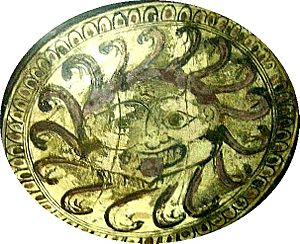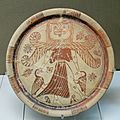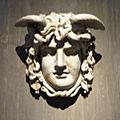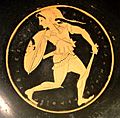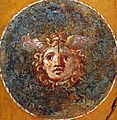Gorgon facts for kids
In Greek mythology, the Gorgons were scary female monsters. They had fangs and snakes for hair. They also had bronze claws. The snakes in their hair were very special. Anyone who looked at them would turn into stone!
There were three Gorgons. Their names were Stheno, Euryale, and Medusa. Only Medusa could die. A hero named Perseus cut off her head. Medusa's head was later given to the goddess Athena. You can often see pictures of Athena with a Gorgon's head on her chest, usually on her shield or armor.
Contents
The Gorgon Sisters
The Gorgons were the daughters of two ancient sea gods. Their parents were Phorkys and Keto.
The three sisters were:
- Stheno: Her name means "the powerful one."
- Euryale: Her name means "who could jump far."
- Medusa: Her name means "the queen" or "trouble-ridden."
Medusa was the only one of the three sisters who was not immortal. This means she could be killed. The other two, Stheno and Euryale, lived forever.
Where Did They Live?
The ancient Greek writer Homer only mentioned one Gorgon. Later, another writer named Hesiod named all three sisters. According to Hesiod, the Gorgons lived far away. They lived at the very edge of the known world. This place was thought to be in the Atlas Mountains.
Later on, another place was also named as their home. This place was Libya.
The Myth of Alexander the Great's Sister
During the Hellenistic period, a new myth about a Gorgon appeared. In this story, the Gorgon was said to be a sister of Alexander the Great. She was a water spirit.
This water spirit would ask sailors on passing boats a question. She would ask if Alexander the Great was still alive. If the sailors answered "no," she would pull their boat and them into the water. To save their lives, the sailors had to answer: "Yes, and he reigns as a king!" In Greek, this was "Ζεί και βασιλέβει."
Gorgons in Art and Magic
The heads of the Gorgons were often shown on many items. You could find them on shields, capes, and amulets. People believed these items had special magic.
This magic was used to protect against bad spirits. It also protected against bad luck or evil looks. This type of magic is called apotropaic magic. It means turning away evil.
Images for kids
-
A Gorgon head on the outside of each of the Vix-krater's three handles, from the grave of the Celtic Lady of Vix, 510 BC
-
Disk-fibula with a gorgoneion, bronze with repoussé decoration, second half of the 6th century BC (Louvre)
-
An archaic Gorgon (around 580 BC), as depicted on a pediment from the temple of Artemis in Corfu, on display at the Archaeological Museum of Corfu
-
Winged goddess with a Gorgon's head, orientalizing plate, c.600 BC, from Kameiros, Rhodes
-
An Amazon with her shield bearing the Gorgon head image. Tondo of an Attic red-figure kylix, 510–500 BC
-
First century BC mosaic of Alexander the Great bearing on his armor an image of the Gorgon as an aegis (Naples National Archaeological Museum)
See also
 In Spanish: Gorgona para niños
In Spanish: Gorgona para niños


